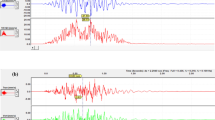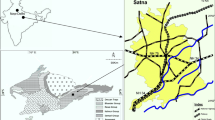Summary
Holcim Eclépens produces about 650,000 tons of cement per year. To supply the plant with sufficient raw material in 2005 about 670,000 tons of limestone were extracted at the "Mormont" quarry by drilling and blasting. About 200,000 t were mined at the "Marniére" marl quarry by using an excavator. Since many years Eclépens, a village nearby the "Mormont" quarry, has been complaining about ongoing blast vibrations. Therefore, Holcim guaranteed to keep the future blast vibrations below 3 mm/s, which was distinctly below the legal limit. In 2005 Holcim decided to increase the raw material extraction by 30 %. As the people of Eclépens feared an increase of blast vibrations, too Holcim set up the working pro-gram "concept carrière 2005" to analyze critically the future impact of that extraction increase. Today, after more than 160 production blasts, only three single blasts exceeded the 3 mm/s limit. The majority of the blast vibrations are distinctly below 2 mm/s.
Zusammenfassung
Das Zementwerk der Holcim Eclépens produziert jährlich ca. 650.000 t Zement. Die jährlich für die Zementherstellung benötigten 670.000 t Kalkstein werden mittels Bohren und Sprengen im Steinbruch "Mormont" gewonnen. Die zusätzlich benötigten 200.000 t Ton- und Mergelstein werden im Steinbruch "Marniere" durch mechanische Gewinnung aus dem Gebirgsverband gelöst. Seit wenigen Jahren beschweren sich Bürger des nahe liegenden Dorfes Eclépens über – die Ihrer Meinung nach – zu hohen Erschütterungen einzelner Sprengungen. Um auch weiterhin eine solide Basis für die Zusammenarbeit zu haben verpflichtete sich Holcim Eclépens zu folgender Regelung: die maximale Erschütterungslimite für alle zukünftigen Sprengungen muss unter 3 mm/s liegen (was bekanntlich deutlich unter der gesetzlichen Limite liegt). Als in 2005 Holcim beschloss die Rohmaterialproduktion um weitere 30 % zu steigern befürchteten die Bürger von Eclépens eine neuerliche Zunahme der Sprengerschütterungen. Die Werksleitung war sich dieser Reaktion bewusst und lancierte das Steinbruchoptimierungskonzept "concept carrière 2005", welches kritisch den Einfluss der zukünftigen Bohr- und Sprengarbeit bewerten sollte. Nach dem Abtun von über 160 Produktionssprengungen kann folgender Leistungsausweis erbracht werden: der überwiegende Anteil der Sprengerschütterungen liegt deutlich unter 2 mm/s und nur 3 Sprengungen erreichten den maximal zulässigen internen Grenzwert von 3 mm/s.
Similar content being viewed by others
References
Jimeno, Carlos et. al. (1995) Drilling and blasting of rocks, A.A.Balkema Publisher, ISBN 905410199 7
Moser, P. & Reichholf G. (2006) Experience with the change from cartridged to bulk site sensitized emulsion products, Fragblast 8, Santiago de Chile 2006
Schachinger, T. (2005) Analysis of the drill and blast work in the Eclépens quarry of Holcim (Switzerland) with respect to blast vibrations, Diploma thesis, Montanuniversity of Leoben 2005
Author information
Authors and Affiliations
Rights and permissions
About this article
Cite this article
Reichholf, G., Brodard, C. & Honorat, M. Critical Investigation into the Drilling and Blasting Work done at the "Mormont" Quarry in Order to Reduce Blast Vibrations. Berg Huettenmaenn Monatsh 153, 138–142 (2008). https://doi.org/10.1007/s00501-008-0365-6
Issue Date:
DOI: https://doi.org/10.1007/s00501-008-0365-6




